How To Add A Dmca To Wordpress Blogs
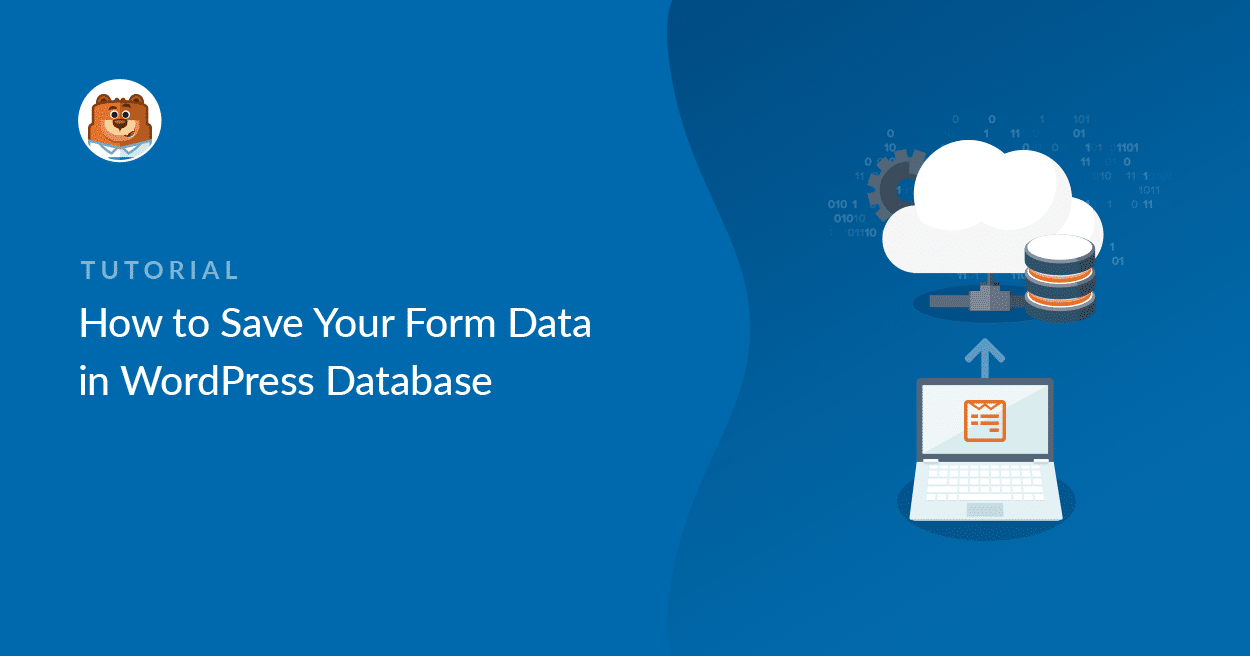
Want to save your site's form submissions with a WordPress database plugin? With the WPForms plugin, it's super easy to manage your form submissions right from your WordPress dashboard.
In this post, we'll show you exactly how to save contact form data in your WordPress database and how to manage your entries from the dashboard.
How to Save Form Data in WordPress Database
Here's a table of contents of this post:
- Where Is the Database in WordPress Stored?
- How to Access the WordPress Database
- How to Manage Entries in WordPress
- Not Getting Emails? What to Do
Create Your Online Form Now
Where Is the Database in WordPress Stored?
Even though you might not see it on the front end, WordPress will automatically create a database for you when it's first installed. The name, host, username, and password data are stored in the configuration file called wp-config.php under MySQL database settings.
WPForms is an online form builder with WordPress data collection features. The WPForms plugin automatically stores all form data in 4 tables within the native WordPress database. They are:
WPForms is the best WordPress Form Builder plugin. Get it for free!
- wp_wpforms_entries: The info inside the fields (values) of your entries are stored in this database table
- wp_wpforms_entry_meta: This table has meta info about your entries like associated IDs and dates
- wp_wpforms_entry_fields: This table contains encoded entry information from your forms
- wp_wpforms_tasks_meta: This table stores information about tasks that are processed in the background.
Note that the wp_ prefix in the table name is the default. The actual value is set in the wp-config.php file in WordPress. So in your WordPress installation, the prefix may look slightly different.
Most WordPress web hosting providers offer easy-to-use web applications like phpMyAdmin to manage databases after your WordPress installation. Regardless of if you're using unmanaged or managed WordPress hosting.
The name phpMyAdmin may sound strange, but it's just a database management system. It allows users to manage the database entries on their WordPress site using a visual interface. Pretty cool, right?
If you're using Bluehost for your WordPress hosting, you can find the link to the phpMyAdmin database server by scrolling to the bottom of the homepage once logged in under Helpful Links » Advanced » phpMyAdmin:
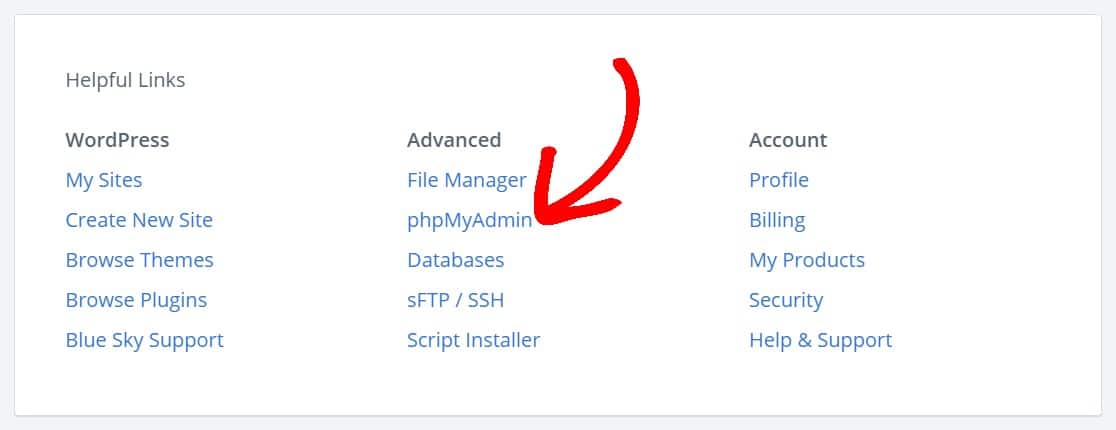
How Do I Access My WordPress Database?
Looking for the WordPress database location? Let's take a look at how to view form entries in your WordPress database using phpMyAdmin.
Here's how to access the database so you can find your WordPress data collection. In phpMyAdmin, select your WordPress database and then click on the table, wp_wpforms_entries.
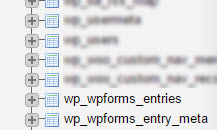
Here, you can find all your form entries in the fields column.
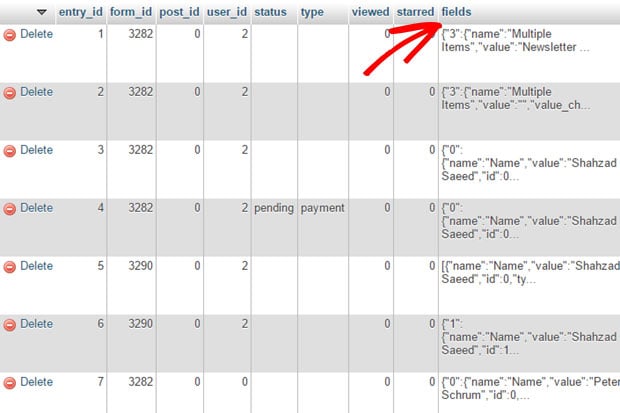
You can do lots of things here like create tables. For more details, you can read this beginner's guide to WordPress database management with phpMyAdmin or check out this video:
How to Manage Entries in WordPress
You may not realize that when you started your WordPress site but it automatically created a database for you for WordPress data collection.
And WPForms lets you easily access your form entries and manage them all inside your WordPress dashboard, acting as a control panel. Storing and retrieving data from the WordPress database is simple.
Let's take a look at how to manage your form entries on your WordPress site.
Before we get started, let's create a simple WordPress contact form with WPForms. If you need help, you can refer to this article on how to create a simple contact form with WPForms.
Make sure you're using a paid version of the plugin. While using the free version of our plugin WPForms Lite, entry data only exists in the notification email that is sent and is not stored in a database.
After publishing the form, make sure to add a test entry so we have some data to access from your WordPress dashboard.
Next, go to your form builder and click on Settings » General. Under the Advanced option, ensure that the Disable entry storing information in WordPress option is toggled off.
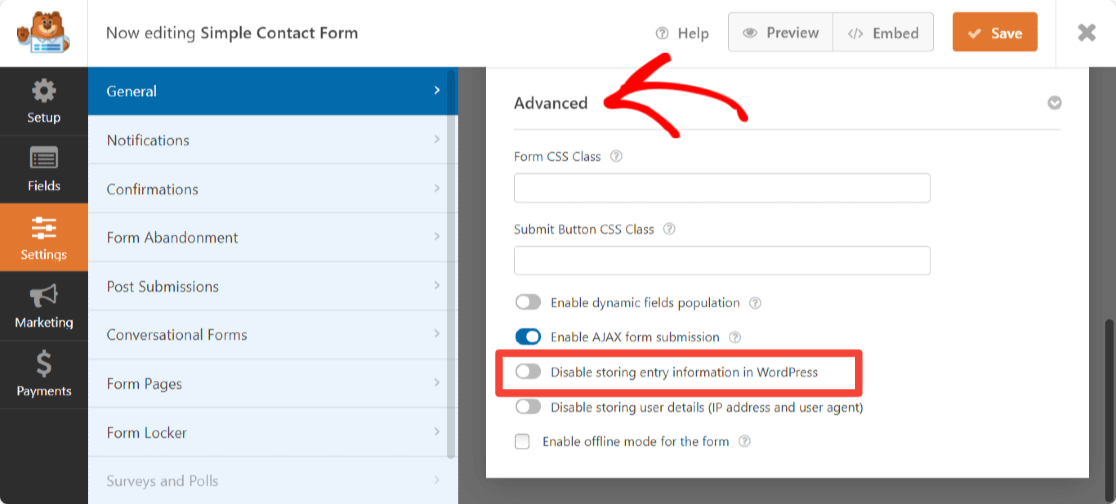
Now, navigate to WPForms » Entries in your WordPress dashboard to see your test entry.
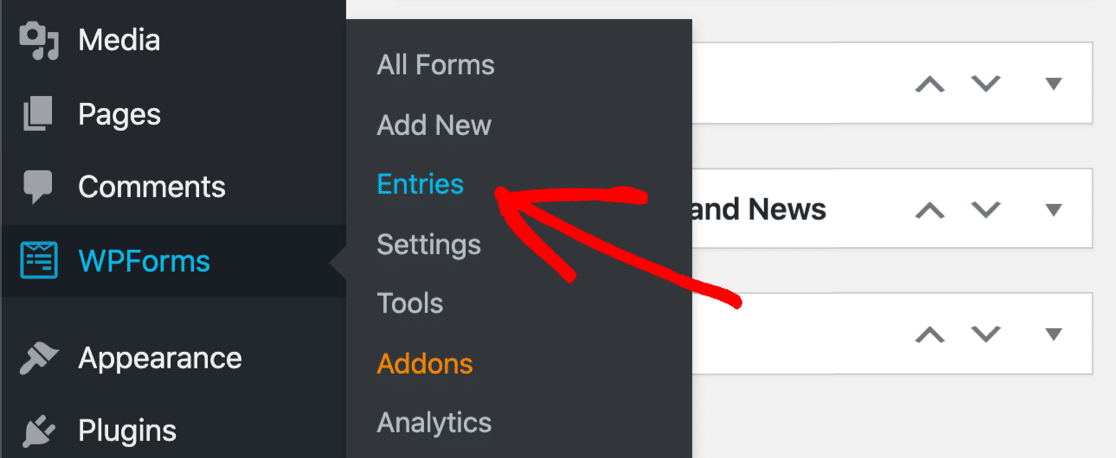
WPForms lets you favorite your entries, mark them as read, and even delete the ones you don't want. Here's a great list of other WPForms power hacks to try.
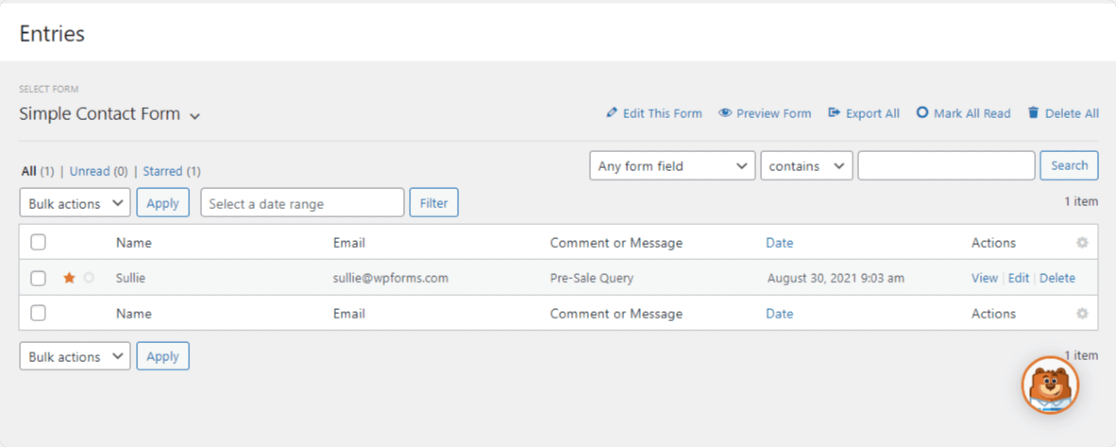
Also, you can easily search and add filters to your form entries within your dashboard. You broad search by Any form field or set conditions across form fields to search for a specific entry.
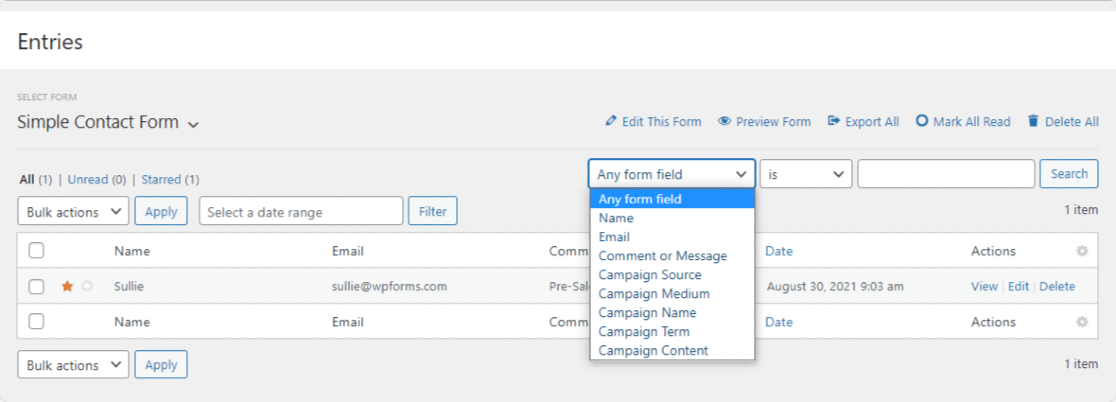
If you want, you can also filter form entries by date.
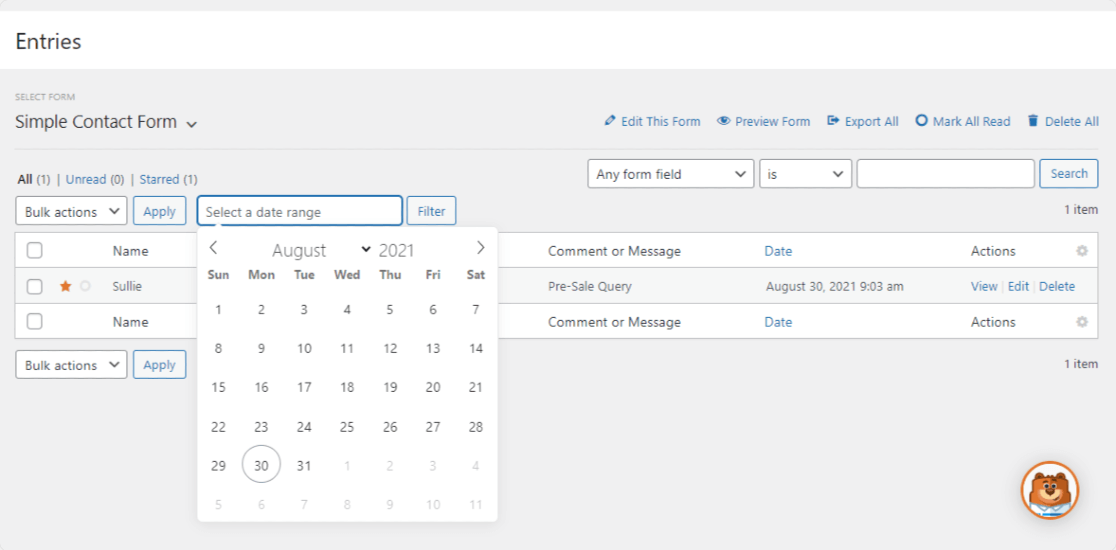
Now, under the Actions column, click View to see your form entry.
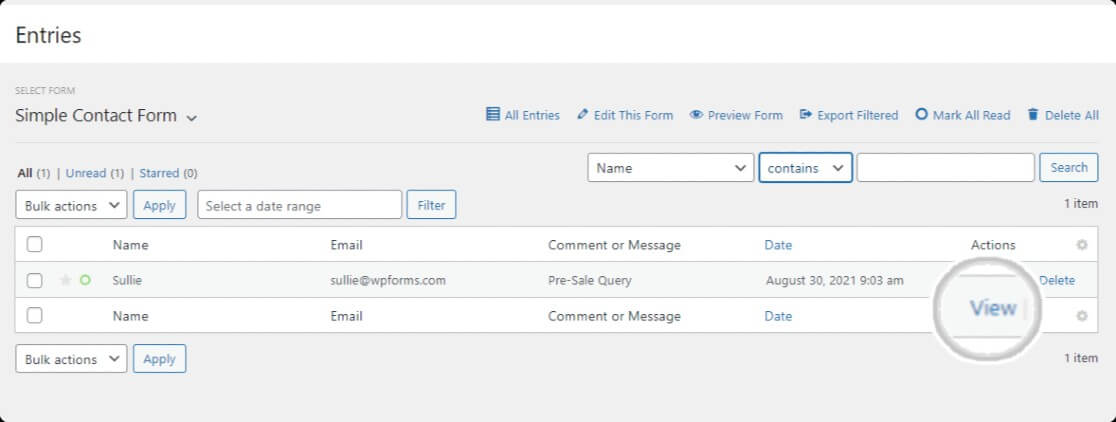
And here's how an individual entry will look.
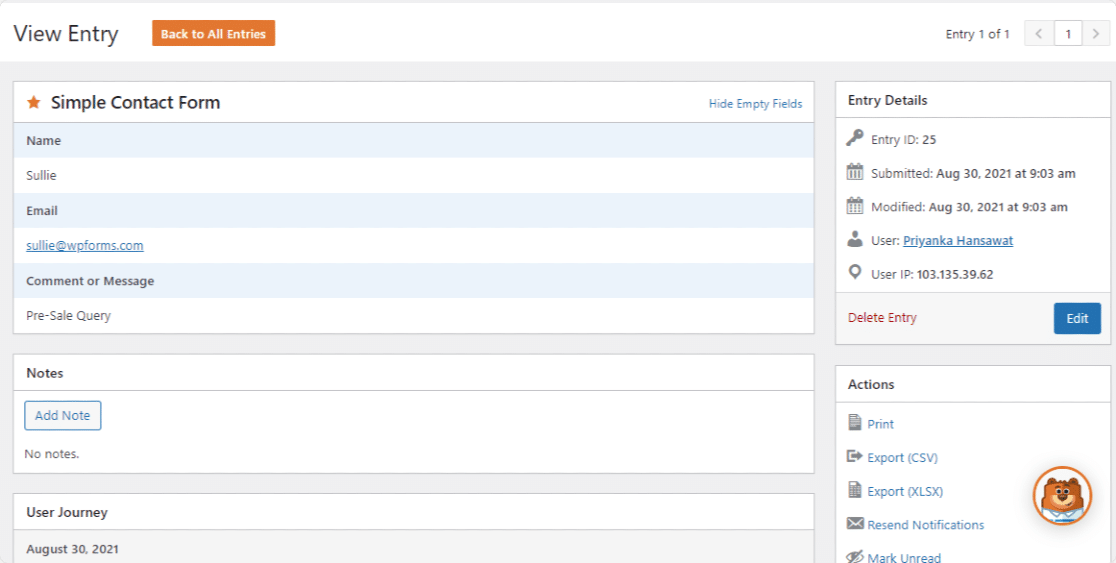
Not Getting Emails? What to Do
If you're seeing your entries in your database but you're not getting email notifications about them, there are usually 2 main reasons:
1. Your Emails Are Seen As 'Spoof' Emails
Spoof emails are similar to spam. Except emails that are suspected of spoofing rarely even make it to an inbox. This usually happens when WordPress sends you a notification when a form is completed using the email of the person who completed it as the "from" sender. This is often flagged as spoofing because this email is coming from your website and masks the actual sender of the email (your WordPress account).
And then, email notifications can get lost and never end up in your inbox.
2. Your Hosting Company Doesn't Use the PHP Mail Function
Another reason you're likely missing email notifications is because of the PHP mail function and your hosting provider.
Your web host may not support the PHP mail function (which is very common these days). WordPress uses the PHP mail function to send emails from your site, including emails generated by contact form plugins. This is why we recommend using SMTP to send emails from WordPress instead of using the default PHP mail function.
Luckily, this is an easy fix.
Install WP Mail SMTP
The easiest and most effective way to fix the Contact Form 7 is not sending email issue for most people is to use WP Mail SMTP. It's the most powerful SMTP and PHP mailer WordPress plugin on the planet. Plus, there's also a free version available.

One of the greatest things about the WP Mail SMTP plugin is that the Elite plan offers a White Glove Setup service where they do all the install and the technical stuff for you. Plus, WP Mail SMTP is integrated with many of the most popular transactional mailers like:
- SMTP.com
- Sendinblue
- Mailgun
- SendGrid
- Outlook
- Zoho Mail
- Amazon SES
- Gmail
To install the WP Mail SMTP WordPress plugin, purchase a paid version (to and start including your emails logs in your WordPress data collection) or head to your WordPress dashboard to install the plugin for free to access basic features. It's the best way to get your WordPress form to the database easily.
There are different steps for each mailer you're using, so to complete setup with this plugin, check out the full guide on how to get WordPress form notifications using the WP Mail SMTP plugin. You'll be receiving emails from your website in no time.
Next Steps With WordPress Data Collection
That's it! You now know how to access and manage your WordPress database with a plugin.
If you enjoyed this article, you might also want to read our articles on how to export WordPress form entries to CSV and how to save form submissions as PDF files.
What are you waiting for? Get started with the most powerful WordPress forms plugin today.
If you like this article, then please follow us on Facebook and Twitter for more free WordPress tutorials.
How To Add A Dmca To Wordpress Blogs
Source: https://wpforms.com/how-to-save-your-contact-form-data-in-wordpress-database/
Posted by: martincongs1974.blogspot.com

0 Response to "How To Add A Dmca To Wordpress Blogs"
Post a Comment